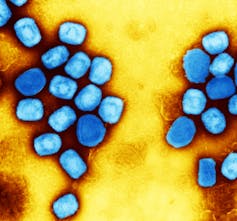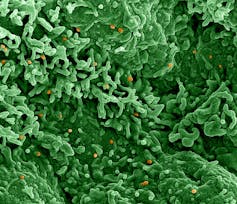is a PhD in Health candidate at .
As we pass the one-month milestone of the current monkeypox outbreak, reports are emerging that the . While this is an important step, more than a name change may be needed.
As a researcher studying metaphors in health, I use to explore how the metaphors used to understand and discuss monkeypox may amplify problematic, discriminatory and dangerous social beliefs.
When an issue is metaphorically framed a certain way, . For example, metaphors used in the context of COVID-19 . Within this frame, actions of ‚Äú,‚ÄĚ ‚Äú,‚ÄĚ and ‚Äú.
In the first month since monkeypox cases have been identified, different frames have been used to understand it. Each has possible consequences.
A metaphorical criminal or child
One way monkeypox is metaphorically framed is as a criminal. This criminal is constructed as having broken out of the West African area in which it had previously been contained. It has been ‚Äúintroduced‚ÄĚ to the ‚Äúcommunity,‚ÄĚ ,‚ÄĚ creating a ‚Äúthreat‚ÄĚ and ‚Äúincreasing risk.‚ÄĚ Monkeypox may even be .

When monkeypox is characterized as a criminal, the reasonable social response is to treat it as such. This is seen in how we describe the response to monkeypox in criminal terms: ‚Äú‚ÄĚ to ‚Äúcontain‚ÄĚ it. We create a story that makes sense given the type of stories we are familiar with, and the words we have available. This can spill over into how we respond to people with the virus.
Monkeypox has also been described as being ‚Äú. In comparison to smallpox, which previously received significantly ‚Äúmore attention and resources,‚ÄĚ .‚ÄĚ
Only now is monkeypox ‚Äúattracting attention,‚ÄĚ ‚Äúmaking itself known‚ÄĚ in ‚Äúunexpected places‚ÄĚ and ceasing to be ‚Äúmute.‚ÄĚ It is ‚Äú‚ÄĚ and inviting itself into our communities. These descriptions combine into a characterization of monkeypox as something of a neglected, rebelling child.
How metaphors feed narratives
The metaphors framing monkeypox occur in the broader context of existing discriminatory narratives. Characterizing monkeypox as a criminal may have problematic consequences when it occurs alongside reports of .
Ongoing LGBTQ+ history is riddled with , where identifying as LGBTQ+ is considered a crime, as well as a .‚ÄĚ Inaccurate descriptions further entrenched these harmful, stigmatizing narratives.
When monkeypox is framed as a criminal in the context of this history, it may strengthen the association between LGBTQ+ identity, illness and criminality.
Similarly, when monkeypox is portrayed as a ‚ÄúBlack‚ÄĚ disease, through the , alongside the ongoing criminalization of Black people, this may further entrench that narrative.
The story of the neglected, rebelling child runs parallel to a larger colonial narrative that . Metaphorically, countries are constructed as people: political ‚Äúbodies‚ÄĚ that interact within, and are part of, a larger ‚Äúinternational community.‚ÄĚ
In these metaphors, . Western countries could be perceived to have a responsibility to help them develop ‚Äúcorrectly‚ÄĚ if they are rebelling, which fuels colonialist attitudes, policies and actions.

Monkeypox characterized as a neglected, rebelling child may blend with broader colonial and racist narratives, fuelling racist beliefs and actions. and other primates. This narrative is evoked in conjunction with the child metaphor through the virus‚Äôs name ‚ÄĒ monkeypox ‚ÄĒ along with descriptions of it originating from particular African regions or countries.
The case for name change
One of the reported reasons for the WHO’s intended name change is to , particularly the names of variants with African countries. There is also a call to .
In the context of broader discriminatory narratives discussed here, this makes sense. Breaking these associations may weaken the link between the language used to understand monkeypox and the broader discriminatory narratives that permeate culture.
However, the metaphors used to understand the virus will still exist. They may still be problematic. As we decide ‚Äúwho monkeypox is,‚ÄĚ we need to consider not only if this is an accurate characterization of the virus, but how this narrative may intermingle with others already in circulation and the harmful consequences this may have on sustaining racist, colonial, homophobic and other discriminatory attitudes and beliefs.![]()
This article is republished from under a Creative Commons license. Read the .

